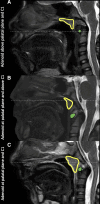Creating a Superiorly Based Pharyngeal Flap: Is Prominence of C1 Superior Enough, and Will Adenoid Pad Be in the Way?
- PMID: 40524880
- PMCID: PMC12169972
- DOI: 10.1097/GOX.0000000000006797
Creating a Superiorly Based Pharyngeal Flap: Is Prominence of C1 Superior Enough, and Will Adenoid Pad Be in the Way?
Abstract
Background: Positioning the pharyngeal flap base high along the posterior pharyngeal wall is essential for optimizing speech outcomes. Objective data on where to place the flap base are lacking. Further, adenoid tissue can restrict cephalad positioning of the flap. This study aimed to improve the design of the pharyngeal flap by measuring the distance from the first cervical vertebrae (C1) to the palatal plane, and the adenoid depth in children undergoing evaluation for velopharyngeal insufficiency.
Methods: This retrospective cross-sectional study analyzed magnetic resonance imaging (MRI) scans of the velopharynx and measured the distance between C1 and the palatal plane, and the adenoid depth at the level of the palatal plane in millimeters.
Results: Thirty-four patients met the inclusion criteria. The mean age at the time of MRI was 7.4 years (range: 3.9-11.9 y). The anterior tubercle of C1 was below the palatal plane in 97% (n = 33) of patients. On average, this landmark was 10.5 mm (SD = 5.0) below the palatal plane. Adenoid tissue was present at the level of the palatal plane in 91% (n = 31) of patients.
Conclusions: Positioning the pharyngeal flap base at C1 is too low to aid with velopharyngeal closure. Further, adenoid tissue is frequently present at the level of velopharyngeal closure, limiting superior positioning of the pharyngeal flap base. When this occurs, surgeons should consider adenoidectomy before pharyngeal flap surgery. Preoperative MRI may be beneficial for planning pharyngeal flap positioning relative to C1 and assessing adenoid tissue at the palatal plane.
Copyright © 2025 The Authors. Published by Wolters Kluwer Health, Inc. on behalf of The American Society of Plastic Surgeons.
Conflict of interest statement
The authors have no financial interest to declare in relation to the content of this article. Research reported in this publication was supported by the National Institute of Dental and Craniofacial Research of the National Institutes of Health under Award Numbers F31DE033236, K23DE025023, and U01DE029750. The content is solely the responsibility of the authors and does not necessarily represent the official views of the National Institutes of Health.
Figures






Similar articles
-
Adenoid hypertrophy causing obstructive sleep apnea in children after pharyngeal flap surgery.Eur Arch Otorhinolaryngol. 2019 Dec;276(12):3413-3417. doi: 10.1007/s00405-019-05633-z. Epub 2019 Sep 13. Eur Arch Otorhinolaryngol. 2019. PMID: 31520163
-
Cephalic de-mucosalized superiorly-based pharyngeal flap: A modified mucosa-preserving technique for velopharyngeal insufficiency.Int J Pediatr Otorhinolaryngol. 2018 Dec;115:65-70. doi: 10.1016/j.ijporl.2018.09.015. Epub 2018 Sep 18. Int J Pediatr Otorhinolaryngol. 2018. PMID: 30368397
-
Does speech improve after delayed palatal closure in Filipino adults? Effects of combined palatal repair, buccinator flaps and suspension pharyngeal flap.Int J Lang Commun Disord. 2025 Jan-Feb;60(1):e13146. doi: 10.1111/1460-6984.13146. Int J Lang Commun Disord. 2025. PMID: 39668794
-
Submucous cleft palate: diagnostic methods and outcomes of surgical treatment.Plast Reconstr Surg. 1996 Jun;97(7):1497-509. doi: 10.1097/00006534-199606000-00032. Plast Reconstr Surg. 1996. PMID: 8643740 Review.
-
Does velopharyngeal closure pattern affect the success of pharyngeal flap pharyngoplasty?Plast Reconstr Surg. 2005 Jan;115(1):45-52; discussion 53. Plast Reconstr Surg. 2005. PMID: 15622230 Review.
References
-
- Kummer AW, Clark SL, Redle EE, et al. Current practice in assessing and reporting speech outcomes of cleft palate and velopharyngeal surgery: a survey of cleft palate/craniofacial professionals. Cleft Palate Craniofac J. 2012;49:146–152. - PubMed
-
- Willging JP. Superiorly based pharyngeal flap and posterior pharyngeal wall augmentation. Oper Tech Otolaryngol Head Neck Surg. 2009;20:268–273.
-
- Emara TA, Quriba AS. Posterior pharyngeal flap for velopharyngeal insufficiency patients: a new technique for flap inset. Laryngoscope. 2012;122:260–265. - PubMed
-
- Sitzman TJ, Williams JL, Singh DJ, et al. Magnetic resonance imaging of the velopharynx: clinical findings in patients with velopharyngeal insufficiency. Plast Reconstr Surg. 2024;153:1155e–1168e. - PubMed
LinkOut - more resources
Full Text Sources
Miscellaneous
